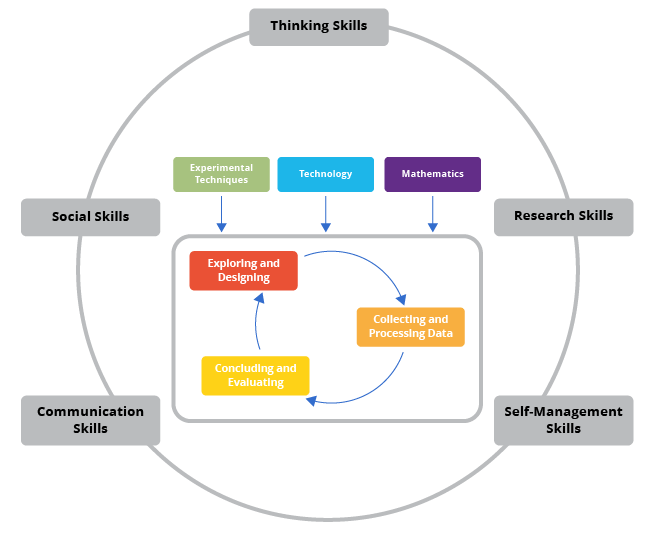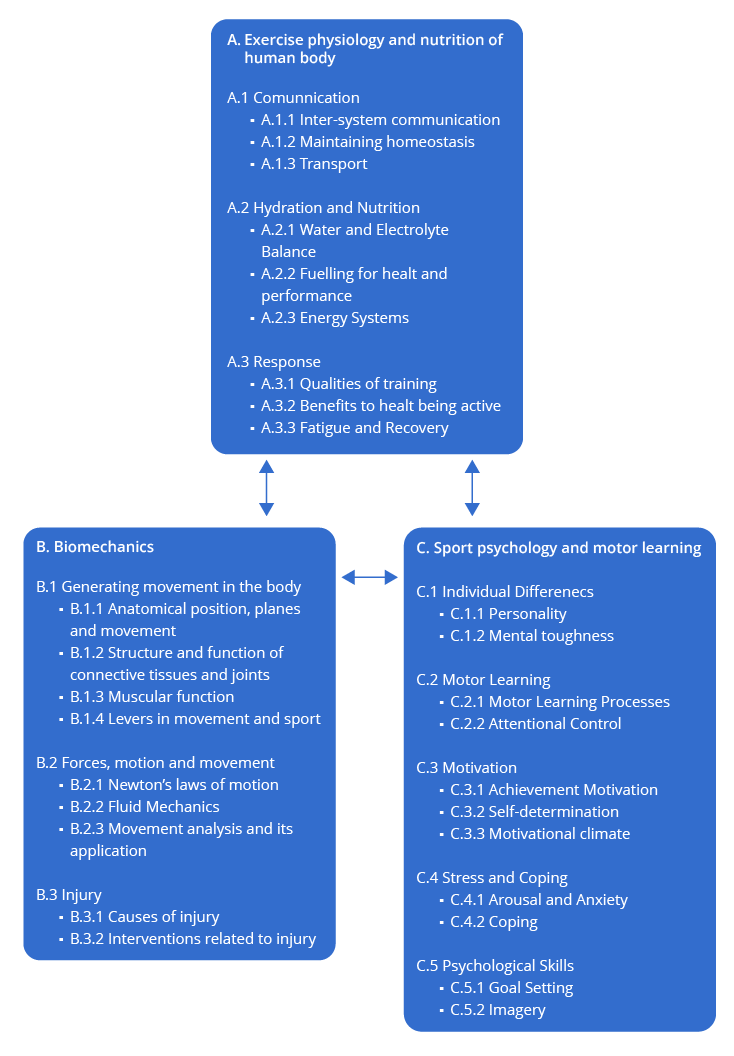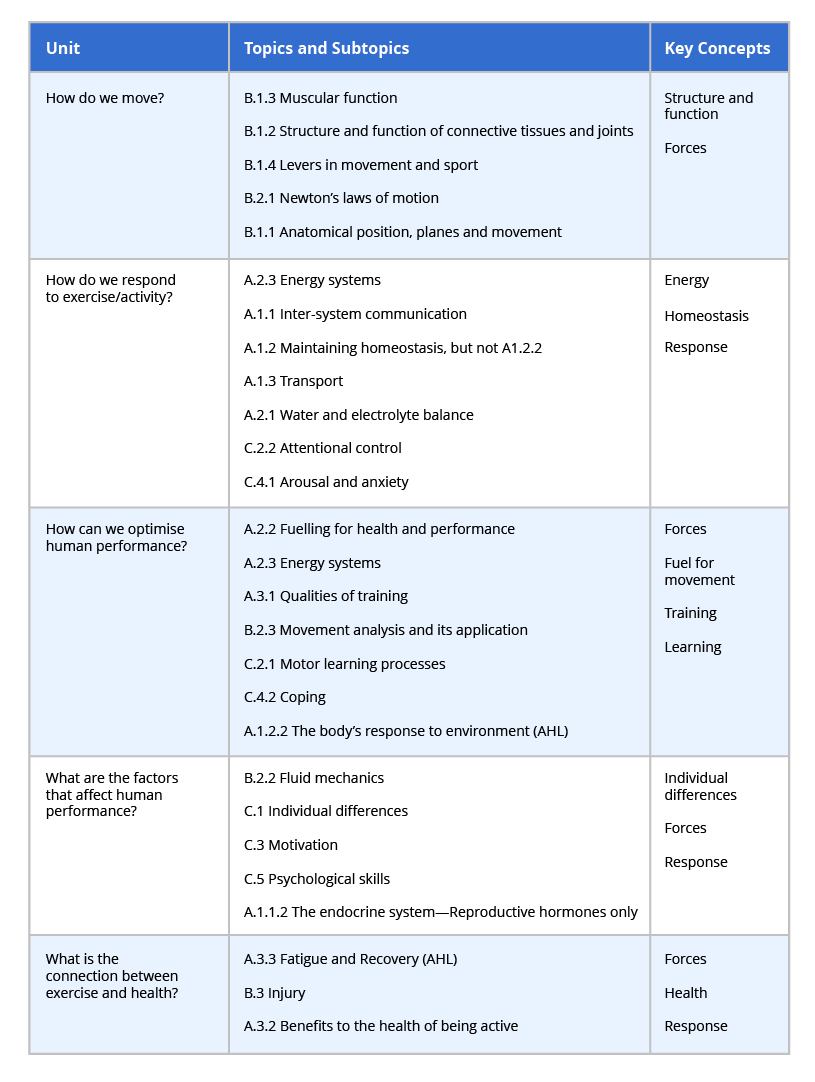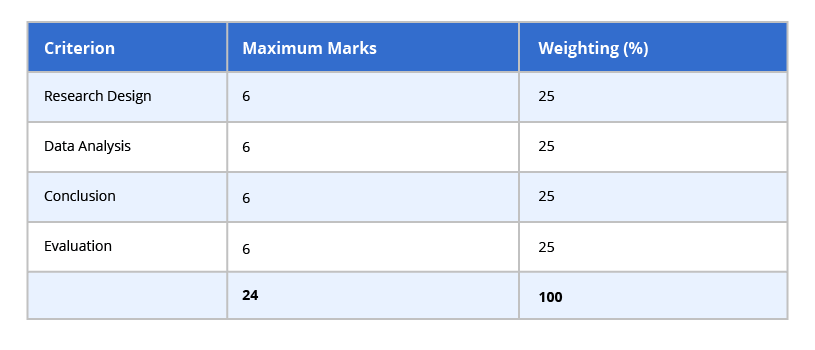
Skills
The syllabus refers to Tools and the Inquiry Process repeatedly to help develop and support the course. Tools- Tool 1: Experimental techniques
- Tool 2: Technology
- Tool 3: Mathematics
- Inquiry 1: Exploring and designing
- Inquiry 2: Collecting and processing data
- Inquiry 3: Concluding and evaluating

Source: Skills for SEHS IB Guide
Content - SEHS Options Removed
The content has been significantly adapted throughout. Although some remain familiar, for example, the physiology section, the first stand-out difference is that the options have been removed; more on this below with assessment changes. Some options content has been subsumed into other units, and some has been deleted. The syllabus statements have become less descriptive, giving teachers greater freedom to challenge our learners as they see fit. I strongly encourage teachers to use the exemplar exams as a guide to pitch the content at the right level. There are individual sections for the skills students need to master for the internal assessment and section 2 of Paper 1. It is well worth mapping out this part of the guide with your new units (available on ManageBac Unit Planner). The other big change is the move towards conceptual, networked learning. The IB roadmap, shown in Figure 1, provides several different possible concept-based pathways or theme-based sequences in which the course could be taught. It does not need to be taught in topic order, which I strongly discourage. The IB encourages teachers to create roadmaps that match their circumstances and needs. The new organisational structure and changes in the arrangement of the content are to highlight and encourage the development of conceptual knowledge in SEHS to help with student understanding. The IB has created a teaching pathway (see Figure 1 below) that teachers might wish to adopt. It is well worth looking out for the linking questions as examples of where teachers can link across the themes (physiology, biomechanics, and psychology) to create a holistic understanding of sports, exercise, and health science. Again, I encourage teachers to develop linking questions to support their students' learning. Note that both syllabi are available in the ManageBac Unit Planner for the transition year, allowing you to switch across any planned units with only a few clicks.
Source: SEHS Syllabus Road Map, IB Guide

Source: A Road Map - adapted from the IB TSM
External Assessment
The external assessment has also received an overhaul. The removal of the options has allowed the consolidation of the three papers into two papers. Paper 1 will have sections A and B. Section A will be multiple-choice (as it was in Legacy Paper 1). Section B will focus on applying our students' content and skills knowledge to unfamiliar data-based material. Paper 2 will be a mixture of a short answer section, similar to Legacy Paper 2, and some extended response questions. The questions will be organised along themes similar to the linking questions. The teacher support material will contain examples of Paper 1 and Paper 2. Specimen assessments are also available on MyIB here. (login required)Internal Assessment - same but different
The internal assessment's essence has not changed; it is still a 10-hour project that accounts for 24% of the student’s final grade. The criteria, though, have changed, and a 3,200-word limit has been added (note that this is slightly higher than Biology, Chemistry, and Physics). The most significant changes are removing personal engagement and communication and dividing the conclusion and evaluation criteria. They now have individual criteria. This is because the conclusion and evaluation will now account for more of the student’s overall grade. Again, there is a difference here between the other sciences. SEHS has an additional descriptor about the implications of the findings on real-world examples. A simple example could be that we found a difference in 100m sprint times of 0.001 seconds, which is unlikely to have any significant effect on the performance of athletes within a game of association football. The new SEHS Internal Assessment criteria are highlighted below: The IB has also added the option of collaboration within the Internal Assessment (IA), which would be done very early in the process and under certain conditions. Students can collaborate on collecting similar data together for their individual research questions.
I am excited about the changes in DP SEHS, and I hope this blog helps you as you start to adapt to the changes.
All the best to you and your students as you start planning for the new guide!
You can find the new guide on MyIB here.
More information on Concept Teaching can be found in our DP Science Concept Guide.
Join me as I look through the changes in the SEHS Guide and their impact on teaching and learning in our upcoming free webinar.
The IB has also added the option of collaboration within the Internal Assessment (IA), which would be done very early in the process and under certain conditions. Students can collaborate on collecting similar data together for their individual research questions.
I am excited about the changes in DP SEHS, and I hope this blog helps you as you start to adapt to the changes.
All the best to you and your students as you start planning for the new guide!
You can find the new guide on MyIB here.
More information on Concept Teaching can be found in our DP Science Concept Guide.
Join me as I look through the changes in the SEHS Guide and their impact on teaching and learning in our upcoming free webinar.

Exploring the New Sports, Exercise, and Health Science Guide
Register NowAbout The Author

Thomas Hetherington
Senior examiner for the IB DP’s SEHS
Thomas Hetherington is a senior examiner for the IB DP’s SEHS. He has been leading workshops and teaching SEHS for over nine years. Aside from this SEHS teaching, Thomas is also an assistant principal at an international school in Geneva, Switzerland. You’ll find Thomas relaxing with his family on the Swiss mountains or lakes when not teaching.
The Learning Management Digest
Subscribe today to receive our latest resources, events, updates and so much more – specially curated for you, and delivered straight to your inbox.
